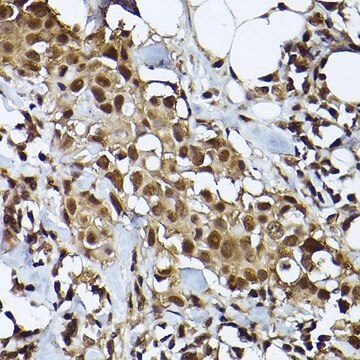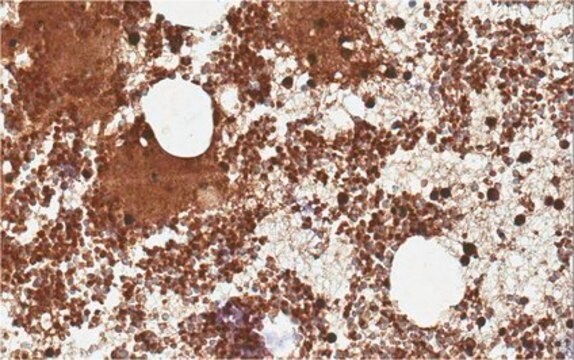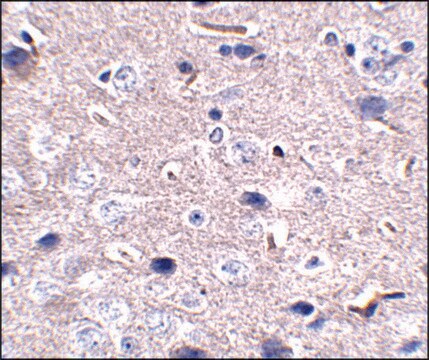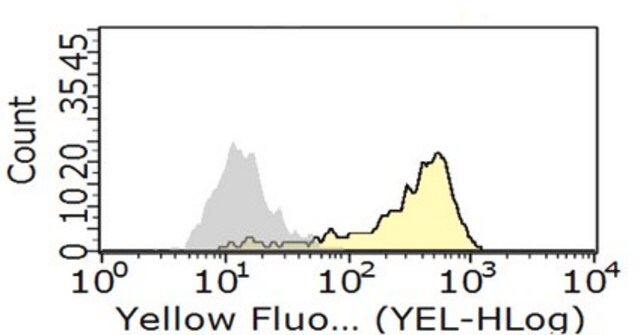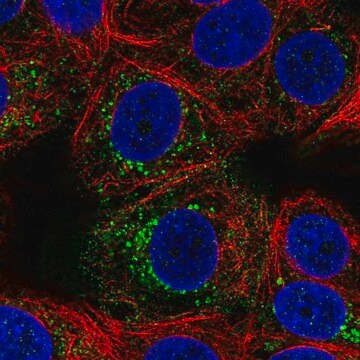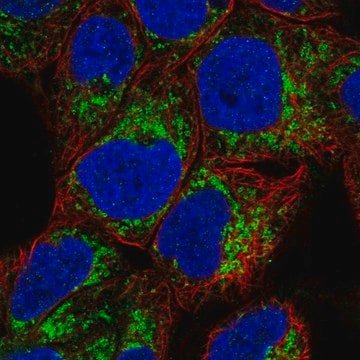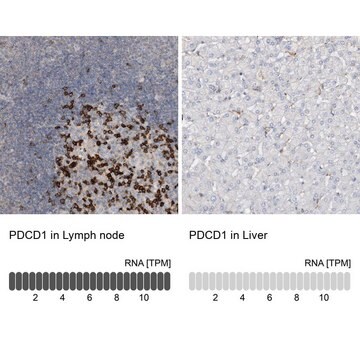MABF842
Anti-FcγRIIb/c Antibody, clone 4F5
clone 4F5, from mouse
Synonym(e):
Low affinity immunoglobulin gamma Fc region receptor II-b/c, IgG Fc receptor II-b/-c, CD32, CDw32, Fc-gamma RII-b/-c, Fc-gamma-RIIb/c, FcRII-b/-c
About This Item
Empfohlene Produkte
Biologische Quelle
mouse
Qualitätsniveau
Antikörperform
purified immunoglobulin
Antikörper-Produkttyp
primary antibodies
Klon
4F5, monoclonal
Speziesreaktivität
human
Methode(n)
flow cytometry: suitable
immunocytochemistry: suitable
immunohistochemistry: suitable (paraffin)
immunoprecipitation (IP): suitable
western blot: suitable
Isotyp
IgG1κ
NCBI-Hinterlegungsnummer
UniProt-Hinterlegungsnummer
Versandbedingung
dry ice
Posttranslationale Modifikation Target
unmodified
Angaben zum Gen
human ... FCGR2B(2213)
Allgemeine Beschreibung
Spezifität
Immunogen
Anwendung
Entzündung & Immunologie
Immunoglobuline & Immunologie
Flow Cytometry Analysis: A representative lot was conjugated with Alexa Fluor™ 647 and detected (at 10 µg/mL) FcγRIIb/c immunoreactivity among the CD19+ B lymphocytes population in human whole blood (Courtesy of Dr. Jeffrey C. Edberg, University of Alabama at Birmingham, USA).
Flow Cytometry Analysis: A representative lot was conjugated with Alexa Fluor 488 and detected FcγRIIb/c immunoreactivity on the surface of EBV-transformed human B cells from various donors (Li, X., et al. (2013). Sci. Transl. Med. 5(216):216ra175).
Flow Cytometry Analysis: A representative lot was conjugated with Alexa Fluor 488 and employed to detect FcγRIIb expression on various human PBMC populations. Highest FcγRIIb level was found on CD19+ B lymphocytes, while lower expression was found among CD14+ monocytes/neutrophils and CD3+ T-cells were negative of FcγRIIb staining (Su, K., et al. (2007). J. Immunol. 178(5):3272-3280).
Flow Cytometry Analysis: Clone 4F5 hybridoma supernatant immunostained murine B lymphoma IIA1.6 cells expressing exogenously transfected human FcγRIIb, but not any of the two polymorphic forms of human FcγRIIa with either Arg131 or His131 (Su, K., et al. (2007). J. Immunol. 178(5):3272-3280).
Immunoprecipitation Analysis: A representative lot immunoprecipitated both FcγRIIb and FcγRIIc from EBV-transformed human B cells and primary human CD19+ cells (Li, X., et al. (2013). Sci. Transl. Med. 5(216):216ra175).
Immunoprecipitation Analysis: A representative lot immunoprecipitated exogenously expressed human FcγRIIb, but not any of two polymorphic forms of human FcγRIIa with either Arg131 or His131 from murine B lymphoma IIA1.6 transfectants expressing the respective human proteins (Su, K., et al. (2007). J. Immunol. 178(5):3272-3280).
Western Blotting Analysis: A representative lot detected exogenously expressed human FcγRIIb, but not any of two polymorphic forms of human FcγRIIa with either Arg131 or His131 in lysates from murine B lymphoma IIA1.6 transfectants (Su, K., et al. (2007). J. Immunol. 178(5):3272-3280).
Immunocytochemistry Analysis: A representative lot was conjugated with Alexa Fluor 488 and detected FcγRIIb/c immunoreactivity on the surface of EBV-transformed human B cells from various donors (Li, X., et al. (2013). Sci. Transl. Med. 5(216):216ra175).
Functional Analysis: Cross-linking by goat anti-mouse IgG (GαM) of clone 4F5 F(ab′)2-bound human FcγRIIb and endogenous surface IgG-BCR on IIA1.6 murine B lymphoma cells expressing transfected human FcγRIIb resulted in a reduced calcium response than that triggered by GαM in the absence of clone 4F5 F(ab′)2. Cross-linking of FcγRIa with clone 4F5 F(ab′)2-bound human FcγRIIb on the surface of U937 cells likewise reduced the calcium response triggered by FcγRIa cross-linking alone (Su, K., et al. (2007). J. Immunol. 178(5):3272-3280).
ELISA Analysis: Clone 4F5 hybridoma supernatant detected recombinant extracellular domain (EC) of human FcγRIIb, but not any of the two polymorphic forms of recombinant human FcγRIIa ECs with either Arg131 or His131 (Su, K., et al. (2007). J. Immunol. 178(5):3272-3280).
Qualität
Immunohistochemistry Analysis: A 1:50 dilution of this antibody detected FcγRIIb/c immunoreactivity in Islets of Langerhans in human pancreas tissue sections.
Zielbeschreibung
Physikalische Form
Lagerung und Haltbarkeit
Handling Recommendations: Upon receipt and prior to removing the cap, centrifuge the vial and gently mix the solution. Aliquot into microcentrifuge tubes and store at -20°C. Avoid repeated freeze/thaw cycles, which may damage IgG and affect product performance.
Sonstige Hinweise
Rechtliche Hinweise
Haftungsausschluss
Sie haben nicht das passende Produkt gefunden?
Probieren Sie unser Produkt-Auswahlhilfe. aus.
Lagerklassenschlüssel
12 - Non Combustible Liquids
WGK
WGK 2
Flammpunkt (°F)
Not applicable
Flammpunkt (°C)
Not applicable
Analysenzertifikate (COA)
Suchen Sie nach Analysenzertifikate (COA), indem Sie die Lot-/Chargennummer des Produkts eingeben. Lot- und Chargennummern sind auf dem Produktetikett hinter den Wörtern ‘Lot’ oder ‘Batch’ (Lot oder Charge) zu finden.
Besitzen Sie dieses Produkt bereits?
In der Dokumentenbibliothek finden Sie die Dokumentation zu den Produkten, die Sie kürzlich erworben haben.
Unser Team von Wissenschaftlern verfügt über Erfahrung in allen Forschungsbereichen einschließlich Life Science, Materialwissenschaften, chemischer Synthese, Chromatographie, Analytik und vielen mehr..
Setzen Sie sich mit dem technischen Dienst in Verbindung.